Archive for June, 2016
Abaixo as Fronteiras! Vivam o Design e as Artes at MUDE
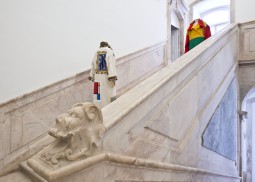
At MUDE and MACE, the exhibition Abaixo as Fronteiras! Vivam o Design e as Artes challenges the hierarchies and reflects on the intersections between design and art.
The exhibit explores the links between design and art in a broad sense, trying to understand what defines the frontiers of two disciplines, and possibly proposing to overcome these boundaries in order to get a richer picture of the connections between two fields so intertwined. This reflection becomes material in the display, which presents objects that stand on the blurred line that divides the disciplines. Drawing from the wide collection of the museum archive, the exhibition puts on stage a dialogue, where the object themselves serve as the main actors.
The role of fashion in this dialogue is, at the same time, complex and essential; fashion itself can be considered a case study to understand the fluidity of the relationship between function and contemplation, innovation and craftsmanship, reproducibility and uniqueness. For this reason, the exhibition features designs by the likes of Alexander McQueen, Ana Salazar, Azzedine Alaïa, Christian Lacroix, Comme des Garçons, Dirk van Saene, Dries van Noten, Gianni Versace, Issey Miyake, Jean-Charles de Castelbajac, Jean-Paul Gaultier, Maison Martin Margiela, Vivienne Westwood and Walter Van Beirendonck alongside other names from the industrial design, architecture and art scenes.
In presenting different styles, chronologies and angles, the exhibition asserts the role of fashion as catalyst in the comprehension of the contemporary value of the concepts of ‘design’ and ‘art’ and, above all, in the interdisciplinarity of the two. The Lisbon display focuses on creators and authors, and fashion designers have historically been pioneers in questioning any static definition and giving material shape to ideas concerning the encounter of personal feelings, the body and the environment.
The exhibition serves also as a reflection on the value of collecting fashion; the destitution of the hierarchy between fine and applied art underlines the value of fashion objects as storytellers, whether they are unforgettable icons of an era, or material memories of everyday and mundane experiences. Fashion in fundamental in museum collections because of its social value, and clothes and accessories are a tangible document of the historical changes in attitudes, tastes and opinions.
Discover more about the exhibition on MUDE Website and explore the MUDE Fashion collection on the Europeana Fashion Portal.
Exhibiting Dress: Enganging with the Past and the Present
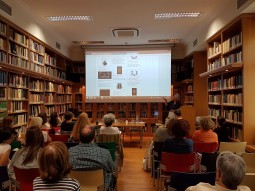
On Saturday 28th May, the Hellenic Costume Society held a symposium to reflect on the practice of exhibiting dress.
The symposium was organised in collaboration with the Netherlands Institute at Athens, and was part of the celebrations in Athens of the International Museum Day 2016. ‘Exhibiting Dress: Enganging with the Past and the Present’ – the title of the event – invited many experts to investigate the approaches and current trends in exhibiting dress in museums, aiming to find innovative ways to pursue the practices of display and exhibition making.

Sofia Pantouvaki, Sjouk Hoitsma, Amy de la Haye, Flavia Loscialpo at the symposium 'Exhibiting Dress: Engaging with the Past and the Present', in Athens. All rights reserved.
Prominent international figures from both museums and academia took part in the conversation, providing interesting insights and case studies to both reflect on the past and think how to move forward. These personalities came from a variety of institutions, and among them we can count Amy de la Haye (London School of Fashion), Sjouk Hoitsma (Museum Rotterdam), Flavia Loscialpo (Southampton Solent University), Sofia Pantouvaki (Aalto University), Monica Titton (University of Applied Arts Vienna); the curatorial teams of many Greek museums holding collections of historical dress were also present, as the Museum of Greek Folk Art, the Peloponnesian Folklore Foundation and the Museum of the History of the Greek Costume.
New and interesting ideas and projects were presented during the sessions; the general direction seemed to consider the audience of fashion exhibitions as active agent in the shaping of the exhibits themselves: most paper featured videos, art and performances designed to engage with materiality and embodiment, trying to provide sensorial as well as visual experiences.

Sjouk Hoitsma from Museum Rotterdam is presenting the digital platform created through the Europeana Fashion project at the symposium 'Exhibiting Dress: Engaging with the Past and the Present', in Athens. All rights reserved.
The use of new technologies and communicative techniques was discussed as well; in this sense, Sjouk Hoitsma, curator of Museum Rotterdam, presented a digital platform created in the context of Europeana Fashion project, giving a good example of how beneficial the cooperation between different institutions can be in the context of museum and fashion practice.
Mainly focused on the involvement of the public in fashion exhibitions, the symposium analyzed initiatives that invited residents in exploring their sartorial and national heritage; in this context, many projects that challenged the very meaning of exhibition and “exhibiting” were presented, stressing on how various the meanings of this practice have become and unveiling the potential of further explorations in the field of fashion exhibitions.
New Theme: ‘The Zoo’
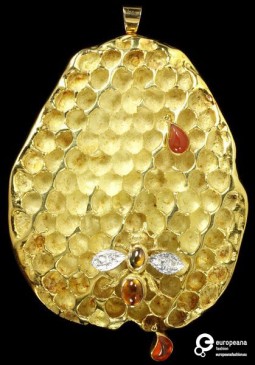
A new theme unveils original items from the Europeana Fashion Collection: an ideal ‘zoo’ gathers a selection of clothing and accessories where animals – in all their forms – are absolute protagonists.
the fascination fashion has had with the animal world doesn’t stop at the use of prints and patterns of animal skins. Even though the first association that comes to mind when thinking about animals and fashion is the use of animalier patterns – and thus the idea of ‘second skin’ – to create illusions and interesting juxtapositions, animals are the actual and unexpected protagonists of many of the items in the Europeana Fashion Collection.
Every society has interpreted animals in different ways, according to the mythologies linked to their behaviour and appearance. Animals have long been associated with well-defined features that identify them with precise characters. Allegorical representation of animals to signify force, beauty or grace are a common practice in many languages, visual as well as written and spoken; actual animals have been transformed by imagination in fantastic entities, such as dragons, and populated legends and magical stories.

Brooch-pendant in the form of a honeycomb in gold, diamonds and fire opals, made by John Donald, London 1969. Courtesy Victoria&Albert Museum
Animals are often associated with fortune or misfortune, and it is no surprise that they have been used as inspiration to create jewels and amulets. They are also often used to define personalities, and both art and fashion have used them as inspirations, metaphors to layer different meanings on objects and artefacts; the ‘amazing creatures’ populate skirts and waistcoats, forming intricate patterns or occupying the whole surface of jumpers and dresses, and have sometimes represented the encounter of different expertise and disciplines – not only art and fashion, but also illustration, biology and botany.
The motifs from the natural world have been translated into true-to-life decorations for clothes and accessories, but there is also a ludic element linked with the appearance of animals as ‘friends’ which makes them suitable for children-wear; the ‘cartoonisation’ of animals is a common practice not only in these kind of clothes, but also in the work of contemporary designers incorporating the idea of playfulness in their creations.
Travel through times and spaces and discover some of the uses of animals in fashion on the Europeana Fashion Portal
New theme: ‘Monochromes’
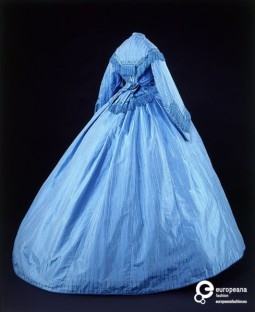
For this new theme, Europeana Fashion explored its collection through its multitude of hues, selecting a bunch of beautiful pieces for which just one colour is enough!
Colour is a constitutive element of fashion and design. It is not possible to conceive a dress, an object or an accessory without considering its color or hue. As colours bring into fashion influences taken from art, history, economy and politics, it is right to consider the choice of a specific colour as important as the shape or cut of a garment itself.

Bodice and skirt, designed by Madeleine Vionnet, 1921. Collection Les Arts Décoratifs, all rights reserved.
The history of fashion is intertwined with the history of colours. In the past as in the presents, different cultures and traditions have used colours to mark or stress distinctions, may those be social or class related; different meanings were – and are – attributed to different colours, according to their rarity, origin and diffusion, and colours were used accordingly to the ‘role’ the clothes had to perform. Some colours have been associated to precise moments or events in people’s life, becoming inappropriate when worn in other occasions.

Bodice and skirt of Jaquard-woven silk trimmed with satin and lined with glazed cotton, Great Britain, 1862. Collection Victoria and Albert Museum, CC-BY-SA.
As for contemporary fashion, not only many designers have their signature colours, like Elsa Schiaparelli’s ‘Shocking Pink’, Emilio Pucci’s ‘Blu Emilio’ and ‘Rosa Pucci’, or the ‘Quattrocento Blu’ of Lanvin; particular colours have been also associated with the work of a designer, as red for Valentino or black for the radical creations of Yohji Yamamoto and Rei Kawakubo; in other cases, colour becomes an essential feature of specific fashion object, as for the famous “petit robe noir”.
From this kaleidoscopic universe, Europeana selected from its collection some of the most interesting examples of colour blocks, presenting them in the new theme: ‘Monochromes’! Have a look at it on the portal, and browse our collection by colour, to find many more fascinating objects!
Let’s Dance!
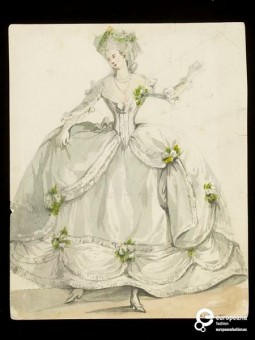
A new theme available now on Europeana Fashion portal: Let’s Dance! A gathering of fashion objects linked to the world of dance.
Well-known to the collective imagination, the ballgown has long been considered the culmination of fashion trends, in many epoques and different geographies.
Dance is a form of expression that has naturally developed in different societies: the research and use of rythm, the excercise of both free and controlled movements, the performative potential of the body are all phenomena examinated by disciplined dealing with human behaviour, such as sociology, ethnography and antropology.
While being often regarded as a moment of freedom, dance has indeed been translated in well-constructed and ‘designed’ events, such as balls and receptions, which were – and still are – occasions for men and women to meet. The birth of society system saw the development of balls as the occasions for young ladies to debut and hopefully find the right partner; the actual dance was the ground where pairs were made, according to the ability to lead and follow, that was considered to mirror the capacity to be a good husband and wife. Still now, the dancefloor is supposed to be one of the best places for couples to meet, being a sort of shared space where people with the same tastes get together and move following the same beat.
Since balls, in all their different formats and venues, are events where ‘to see and be seen’, they call for the right clothes. From the court receptions to the more recent proms, passing through the folkloristic balls, usually performed wearing traditional costumes, and the disco, the ‘dance attire’ has always been about visibility and appearance, arousing in both men and women the desire to appear at their best, in line with the evolving standards of beauty of each time.
Usually designed according to the kind of movement the body has to perform in order to dance, these dresses actively partecipate in the dance itself; their features are not just ephemeral details, but they become fundamentally functional; volants, sequins, accessories: all these details are thought in relation to the environment they are going to get in conversation with, and help the body to move in the right way and to create a precise kind of silhouette.
From a historical point of view, they are often a good starting point to better understand the ideals of beauty and acceptability of the society they come out of. On a more personal level, they visually translate the ambition to appear, to sound, to fly like a bird to the beat of the music: once worn, dance gowns become sort of magic objects, transforming the wearer from duckling into swan and boosting his or her confidence. In any case, they are not only worn to be seen, but above all to be noticed and to be remembered.
Visit Europeana Fashion themes area to see more images and get inspired to discover more about the fascinating links between fashion and dance.
Europeana Fashion meets Paul Van Riel
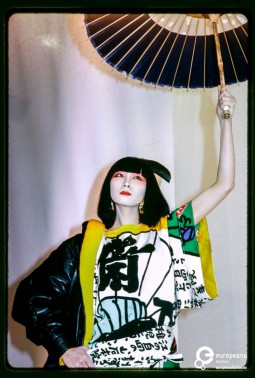
The latest update of Europeana Fashion Archive has seen the publication of the photo archive of the Dutch fashion photographer Paul van Riel, who has recently joined the portal as new content provider.
Amsterdam-based, Dutch freelance photographer with an international career in travel and corporate photography, Paul van Riel has dedicated part of his career documenting fashion shows around the globe. In order to present him and his work, we have asked him to share some memories about his past, his practice and his take on fashion. Here is what he told us.

Fashion show of Kansai Yamamoto winter 1981-1982 women's ready-to-wear collection. Model: Sayoko Yamaguchi. Photo by Paul van Riel. Paris, 1981. Photo © Paul van Riel / HH. All rights reserved.
As we learn from your biography, you have produced photo essays on a wide range of topics and you have travelled a lot. How do you consider your work for fashion, compared to that focused on other subjects?
Fashion photography entered my career only after having been in the business for about 7 or 8 years. In 1974 I tugged along with a friend from Amsterdam, who was a fashion-trade journalist on assignment in Paris, visiting the Salon du Prêt-à-Porter, which was entirely new to me. What started as a nice outing in Paris, quite thoroughly changed my life. I stumbled into a show by Kenzo at the Vieille Bourse and I was approached by various people then and there wanting to buy the rolls of film I had shot. Back home, I contacted a weekly news/lifestyle magazine to shoot a reportage on this Paris fashion scene and within a year, with lots of new contacts, I found myself shooting a growing number of défilés for more than one publication. Till then, my work had mainly been about travel and music photography, the occasional news assignment and some product photography; but between 1975 and 1990 my work schedule was (partly) organized around the fashion show calendars.

Fashion show of Kenzo spring-summer 1982 women's ready-to-wear collection. Applause at end of show. Photo by Paul van Riel. Paris, 1981. Photo © Paul van Riel / HH. All rights reserved.
You are usually recognised as a photographer, but in your work – even in the catwalk pictures – there is a strong creative element, that makes you an ‘image maker’ – or ‘artist’ – in a wider sense. How would you describe yourself and your work, both in general and in relation to the fashion system?
The scene at the Salon and the Kenzo show opened my eyes to a whole new world. I was, and still am, much more interested in the ambiance of these affairs, the social and economic aspects, than in the actual ‘fashion’. Many of the mostly Dutch and Belgian ladies and lifestyle magazines which published my catwalk images, soon asked me to shoot in studio. But to be honest…I preferred to shoot these productions on site; the background, the setting of these shoots were, for me, as important as the clothes themselves. There, I could combine my ‘eye’ for outdoor situations – often without any people in them – with a growing feel for clothing and beauté. It is no surprise that I love the creations of designer Issey Miyake; his work echoes my interest in architecture, sculpture, product design.
In 1989 I decided to bid farewell to the Paris fashion ‘circus’, after fifteen hectic years. It had become too crowded and ‘commercial’. In October of that year, instead of shooting fashion on stage, I shot a twelve page full colour photo essay for the important Dutch opinion magazine Vrij Nederland, focusing on backstage and on the ambiance around the shows; there were models, buyers, aficionados, photographers, journalists, makeup artists and so on.

Fashion show of Issey Miyake spring-summer 1978 women's ready-to-wear collection. Model: Sayoko Yamaguchi. Paris, 1977. Photo by Paul van Riel. Paris, 1981. Photo © Paul van Riel / HH. All rights reserved.
What made you decide to organise an archive of your work? What does the act of archiving mean, to you as an author?
I always held on to almost all the material I photographed over the years, fashion and otherwise, as well as hundreds if not thousands of my published pages of photography; I also kept the full correspondence with clients and organizations, and stacks of notebooks, accounts of travel expenses etc…not very much is being thrown away here. Europeana Fashion gave me the final push to start digitizing all of that, systematically. As it costs too much time to make a representative selection out of all the more than 1.000 shows I photographed in Paris and Milan, I decided to reproduce each entire collection.

Fashion show of Jean-Paul Gaultier spring-summer 1983 women's ready-to-wear collection. Queen Elizabeth look alike. Photo by Paul van Riel. Paris, 1982. Photo © Paul van Riel / HH. All rights reserved.
You have enriched the Europeana fashion portal with an amazing selection of images. Could you give us an idea of the kind of material you decided to share, and why?
Looking back at the Prêt-à-Porter work – some of it is 42 years old – it tells a great story of changing tastes, the influence of various cultures on the global face of fashion (e.g. the Japanese entering the stage in the late 70’s, early 80’s). It really testifies the passage from simple catwalk shows with models holding a card with a number on it, to the outrageous multi-media presentations attended by thousands of people.

Fashion show of Jean Paul Gaultier. Paris, 1989. Photo by Paul van Riel. Paris, 1981. Photo © Paul van Riel / HH. All rights reserved.
As a photographer, in which way would you make use of a resource as Europeana Fashion?
For me, as a photographer now just interested in fashion ‘on the side’, the Europeana Fashion database does offer a lot of information when doing research for future, design related stories.
Search the amazing Paul van Riel‘s collection on Europeana Fashion portal!
For more information, please visit Paul van Riel
Karl Lagerfeld – The Photographer at Pitti Uomo 90

Palazzo Pitti inaugurates a three-year program dedicated to the culture of contemporary fashion with a through-the-lens view of Karl Lagerfeld’s photographic works.
The exhibition “KARL LAGERFELD – Visions of Fashion”, curated by Eric Pfrunder and Gerhard Steidl, opened yesterday, 14th June, in Florence at Palazzo Pitti, during Pitti Uomo 90.; It shows the designer’s photographic production and includes many unpublished pictures.
The pathway starts from the grand staircase, Scalone del Moro, and continues through the rooms of the Galleria Palatina, the Sala Bianca and the two rooms of the Appartamenti degli Arazzi. The artworks are placed to the edges of the space, drawing a neon-enlighted path through the rooms of Palazzo Pitti and culminating in the Sala Bianca, where Italian fashion was first shown in 1951. For this room, the curators have decided to print the photos on lightweight paper, to make them flutter from the ceiling, recalling the ethereal movements of the models gliding on the runway.
The exhibit is a special anthology celebrating Karl Lagerfeld’s diverse and elegant approach to photography. It unveils images from editorials published in the world’s most widespread fashion magazines, such as Vogue, Harper’s Bazaar, Numéro and V Magazine, as well as other original projects, as the ones inspired by classical mythology.
Karl Lagerfeld, fashion designer, photographer, publisher, designer, as well as film director, has begun his photographic production creating the visuals for his fashion shows and the ads for his collections; then his photography ventured also into other territories. At his studio in Rue de Lille, one of the last still shaped as the iconic ones of the nineteenth and early twentieth century, he has been capturing all the world’s most well-known personalities onto a white paper cyclorama, contributing greatly to contemporary visual culture. His capacity to observe and perceive the world with a very peculiar eye forms a continuum with his work as fashion designer, and fits perfectly within his creative process.
The whole event was made possible thanks to the recent collaboration between the Gallerie degli Uffizi and the Fondazione Pitti Immagine Discovery, with the support of Centro di Firenze per la Moda Italiana and Pitti Immagine. The exhibition will be on show from June 15th to October 23rd .
Learn more about it in the Europeana Fashion event area!
Pitti Archive: “The Fourth Sex. Adolescent Extremes”

Starting today, Pitti Uomo 90 will present during the week various events, among those “Florence Calling: Raf Simons”.
The event, to be staged in Stazione Leopolda in the evening of Thursday 16th June, celebrates the return to Florence of Belgian fashion designer Raf Simons.
The designer, creative director of Christian Dior from 2012 to 2015 and of Jil Sander from 2005 to 2011, was invited following a series of successful collaborations with Pitti Uomo and Fondazione Pitti Discovery; these include the exhibition “The Fourth Sex – Adolescent Extremes” in 2003, the retrospective “Raf Simons 1995-2005”, the presentation of the book “Raf Simons Redux” with a fashion show and video installation in 2005, and the Jil Sander s/s 2011 runway show.

The exhibition “The Fourth Sex. Adolescent Extremes”, staged in Stazione Leopola during Pitti Uomo 63. Photo by Carlo Fei. Collection Pitti Immagine, all rights reserved.
In particular, the 2003 exhibition gives a meaningful insight in Simons’ world. Co-curated by Francesco Bonami, then artistic director of Fondazione Pitti Discovery, and Simons himself, the exhibit reflected upon a central figure in the work of Simons, the teenager; seen as a cultural phenomenon, that of adolescence was explored as a territory defined by very specific tastes, tendencies and interests, although being chaotic in its state of continuous formation.

The exhibition “The Fourth Sex. Adolescent Extremes”, staged in Stazione Leopola during Pitti Uomo 63. Photo by Carlo Fei. Collection Pitti Immagine, all rights reserved.
These ‘adolescent extremes’ have been explored, in the exhibition and in its catalogue, by the work of a multitude of artists, directors, fashion designers and musicians who, since the 60s, have been investigating, getting inspired or inspiring teenagers. They include, among others, photographers Andreas Gursky, Larry Clark, Wolfgang Tillmans, artists Vanessa Beecroft, Gilbert&George, Takashi Murakami and fashion designers André Courrèges, Pierre Cardin, Bernhard Willhelm, Comme des Garçons, Helmut Lang and Fiorucci.

The exhibition “The Fourth Sex. Adolescent Extremes”, staged in Stazione Leopola during Pitti Uomo 63. Photo by Carlo Fei. Collection Pitti Immagine, all rights reserved.
Installed at Stazione Leopolda by the architect group ‘Cliostraats’, the exhibition drew inspiration from these diverse languages and media to outline teenagers’ grammatics and codes. The value of the exhibition stands in the representation of adolescence as an aesthetic category, serving not only as an inspiration but also as a strong influence in fashion, art, music and cinema.
Pictures of “The Fourth Sex. Adolescent Extremes”, as well as those of the fashion show staged at Giardino dei Boboli in 2005 are provided by Fondazione Pitti Immagine and can be found in the Europeana Fashion collection. Browse them while waiting for the upcoming event on Thursday 16th!
Crowdheritage Workshop at MoMu
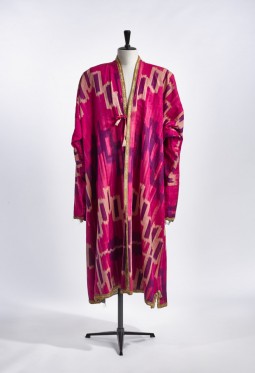
Will the heritage of tomorrow be financed and curated by the crowd?
On Tuesday 14th June, MoMu – Fashion Museum Province of Antwerp is hosting a workshop on crowdfunding and crowdsourcing. Addressed to cultural heritage professionals, the workshops aims to teach how to engage users to let them make contributions to cultural heritage collections through crowdfunding and co-creation.
Crowdfunding and crowdsourcing are two popular practices in museum management, consisting in the involvement of large number of people in raising contributions and in obtaining informations, typically via the Internet. In 2014, more than 16 billion dollars were raised via crowdfunding worldwide.
The case study for the workshop will be MoMu’s Study Collection, which is being set up by the museum in collaboration with the University of Antwerp. This collection will offer the opportunity to initiate a new dialogue with the Museum’s users; in fact, the main aim is for the collection to be usable and reusable in all its aspects and potential. To support this main idea, the museum is also working together with Goteo Foundation to build a hybrid crowdfunding and crowdsourcing framework, in order to set up a ‘usable’ fashion museum.
The workshop will investigate the ways crowd engagement can help open standards for collaborations and how this collaboration could help design a comprehensive, educative lab context. Moreover, the session will try to define how it is possible to integrate the entire process of conception, design, prototyping and financing for the development of new projects. Will the crowd bring more social innovation to the long-term planning required to determine the future of the common cultural heritage?
The workshop is organized with the support of the Europeana Foundation. To learn more about the program, visit MoMu website. To register to the event, please visit Eventbrite.
Conference: “History, Production, Trade and Use of Venetian Textiles”

From the 25th to 27th May, Palazzo Mocenigo in Venice hosted the International Conference on Venetian Textiles.
The role of textiles has been central in the culture, economy and history of Venice, in the past as in present days. The fabrics produced in Venice were traded in and outside the island as luxury goods; they became characteristic of a typically Venetian artistic environment and crucial in the definition of a Venetian fashion in clothing and interior decoration.

The Centro Studi di Storia del Tessuto e del Costume di Palazzo Mocenigo, home to one of the largest collections of ancient textiles, recently hosted a conference on ‘History, Production, Trade and Use of Venetian Textiles’, in which international experts, historians and other scholars were invited to share their knowledge on the topic.
The aims of the conference were to frame Venetian fabrics in the wider histories of textiles and trade, and to create a network of the most important textiles’ collections around the world; the informations gathered and discussed during the event will lead to a thorough publication, focusing on production techniques, trade and diffusion of Venetian textiles, as well as on their collections and relations to fashion.
During this week, from the 4th to the 13th June, Palazzo Mocenigo is engaged in the “Biennale del Merletto”. The international event features installations, talks and workshops on the art of merletto, and is hosted in different locations around the islands of Venice, Burano and Pellestrina. During these days, it is possible to visit the “Scuola del Merletto” in Pellestrina and to have a tour of the Museo del Merletto in Burano, as well as taking part in other relevant cultural events. Have a look at the complete list of the events to learn more about the conferences, concerts and lectures.
To learn more, visit Palazzo Mocenigo or take a look at their website.
To find out about other fashion events happening now all around the world, visit the Europeana Fashion events area.














